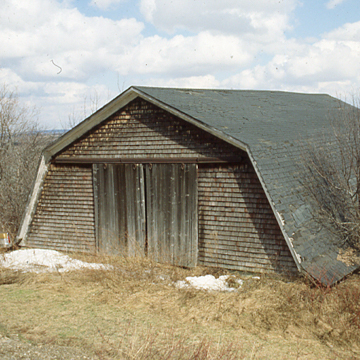You are here
Larsson-Ostlund Potato Cellar
The Larsson-Ostlund Potato Cellar is part of a large agricultural complex in rural New Sweden. The New Sweden Colony and the commercial cultivation of potatoes underscores Maine’s efforts to halt a major outmigration in 1850–1870 and to create a viable state agriculture competitive with that of the Midwest. In 1868 Maine opened the State College of Agriculture and Mechanic Arts at Orono (now the University of Maine) and launched the establishment of crops suitable for commercial cultivation in Maine, mainly sweet corn, blueberries, and potatoes.
Another effort began in 1861 to actively encourage Swedish immigration to Aroostook County. Although French-Canadians had settled there since 1832, when the Military Road connected the isolated county to the Penobscot River at Houlton, by 1860 outmigration had eroded the small population and the state legislature appointed a Committee on Swedish Immigration to recruit immigrants with the promise of 100 free acres and free tools. Swedish immigrants arrived the following decade, bringing with their log house construction. By 1880 the residents of New Sweden had 4,438 acres under cultivation, including 25,000 bushels of potatoes, and had built a church, five school houses, and 162 dwellings. With the arrival of the Bangor and Aroostook Railroad in 1894, the population of New Sweden exceeded 800.
One of the 162 dwellings in New Sweden belonged to the Larsson family. A one-story log house on the east side of Station Road, it was built employing traditional Swedish dovetailed joinery. The Larsson property consisted of 100 acres on Lot 121, located high on Capitol Hill, on which they built a barn and planted a potato crop. In 1888 the Larssons replaced their first log house with a similarly constructed two-story house. In 1899 Larsson deeded thirty acres of his farm to his son, Noak.
George Ostlund purchased the bulk of Lot 121 from the Larssons in 1910, and it was Ostlund who built the potato cellar in 1928. As under Larsson, potatoes remained the important cash crop. The two-story, gambrel-roof potato cellar, built into the side of a hill to take advantage of the cool ground temperature on both levels, sits not far from the 1888 log house. It rests on a concrete foundation. The shingled, west gable end of the potato cellar that faces Station Road has two large sliding (track-mounted) doors that open into the second-floor storage space. The east gable end, also shingled, has a similar sliding door. Access to the first floor is lower on the hill. The second-story windows are now boarded shut. Each of the north and south elevations are likewise shingled. The first-story interior of the potato cellar is divided into two large storage areas surrounded by concrete walls. Near the first-story entrance doors sits a working wood-burning stove.
The potato cellar and surrounding buildings form part of the Larsson-Noak Historic District. Today the site is managed by the Swedish Colony, Inc., a preservation society organized in 1989, in cooperation with the New Sweden Historical Society.
References
Mahoney, Kirk, “Larsson-Noak Historic District,” Aroostook County, Maine. National Register of Historic Places Inventory Form, 1989. National Park Service, U.S. Department of Interior, Washington, D.C.
Richard Hede, ed. Maine’s Historic 1870 Swedish Colony. New Sweden: Maine Swedish Colony, Inc., 2001.
Writing Credits
If SAH Archipedia has been useful to you, please consider supporting it.
SAH Archipedia tells the story of the United States through its buildings, landscapes, and cities. This freely available resource empowers the public with authoritative knowledge that deepens their understanding and appreciation of the built environment. But the Society of Architectural Historians, which created SAH Archipedia with University of Virginia Press, needs your support to maintain the high-caliber research, writing, photography, cartography, editing, design, and programming that make SAH Archipedia a trusted online resource available to all who value the history of place, heritage tourism, and learning.














